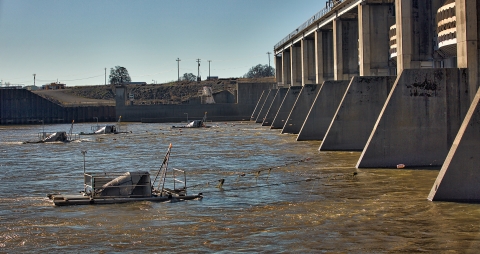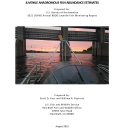Red Bluff Diversion Dam Juvenile Fish Monitoring
The primary objectives of this project on the Sacramento River are to obtain juvenile winter-run Chinook salmon production indices and to correlate these indices with estimated escapement from adult estimates provided by the winter Chinook carcass survey; define seasonal and temporal patterns of abundance of winter, spring, fall and late-fall run Chinook salmon and steelhead trout passing the dam; and obtain relative abundance information for green sturgeon and lamprey to monitor trends in abundance.
These data are shared with our partners and interested stakeholders in a variety of ways. The juvenile monitoring program currently provides bi-weekly, real-time, summarized daily passage estimates of all four runs of Chinook salmon and steelhead to the CALFED Operations Data Assessment Team and Operations and Control Office. Passage data are provided to water managers at the federal Central Valley Project's Tracy Pumping Plant and the State Water Project's Harvey Banks Delta Pumping Plant on a real-time basis to minimize the likelihood that juvenile winter-run Chinook will be caught or diverted by pumping operations at these facilities. Data are also accessible from the Central Valley Prediction and Assessment of Salmon website.
History of juvenile salmonid monitoring at Red Bluff Diversion Dam
The Sacramento River system is unique in that it supports four runs of Chinook salmon. Named for the season the majority of adults enter San Francisco Bay on their spawning run, these four runs include fall, late-fall, winter and spring-run Chinook salmon.
The Red Bluff Fish and Wildlife Office established a juvenile fish monitoring program using rotary screw traps at the Red Bluff Diversion Dam in 1994. The initial objectives of the juvenile monitoring program were to assist in the evaluation of the Red Bluff Research Pumping Plant. The plant was constructed by the Bureau of Reclamation to provide an alternative method for delivering agricultural water to the Tehama-Colusa Canal, rather than the diversion system currently in place.
Juvenile passage estimates for steelhead and all four runs of Chinook salmon, and relative abundance information for a host of other native and exotic species, were generated and provided to the Bureau to determine possible impacts on fish from operation of the plant. Rotary screw traps were used to evaluate the pumping plant from July 1994 through June 2000. Sampling was not conducted from July 2000 through March 2002 while funds were being secured through the California Bay-Delta Authority, but resumed in April 2002 and have continued to the present day.
The dam, located at river kilometer 391 on the Sacramento River, about four kilometers southeast of the city of Red Bluff, California, has proven to be an ideal site for juvenile Chinook salmon monitoring. Moreover, the site is superlative for the monitoring of endangered winter-run Chinook salmon because the winter Chinook salmon spawning grounds lie almost exclusively above Red Bluff Diversion Dam. Also, up to four 8-foot diameter traps can be attached to the dam and sampled simultaneously.
Before the complete reliance on the pumping plant to supply water to irrigators, the operations and physical structure of the dam controlled the hydrological characteristics of the area. This provided for consistent sampling conditions for evaluating trends in juvenile abundance within and between years, and for developing a time-invariant trap efficiency model. The model and quantitative methodologies were developed to estimate numbers of fish passing the dam while decreasing the program’s reliance on and need for experimental fish, thereby minimizing impacts on threatened and endangered species. These methodologies have been independently reviewed by biological statisticians.
To be added to the list of recipients who are provided biweekly reports, please email redbluff@fws.gov.










